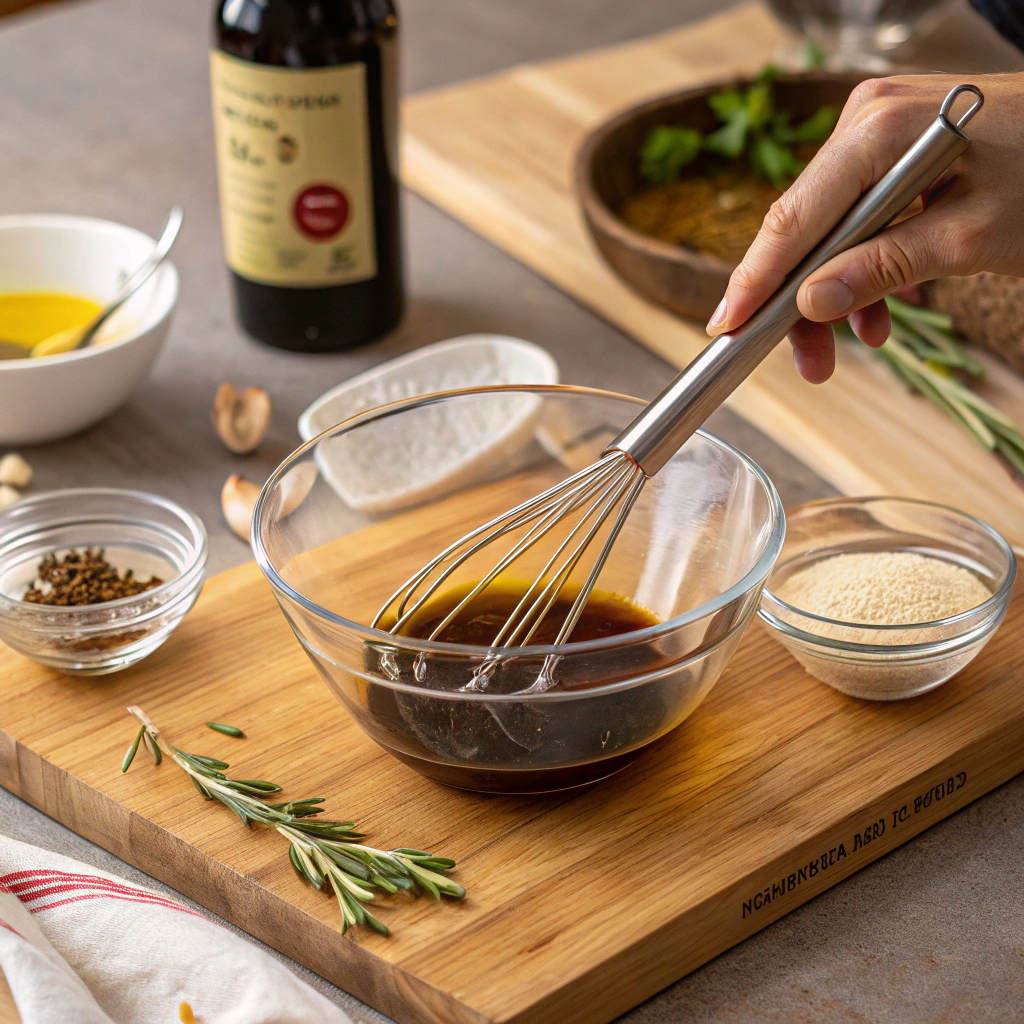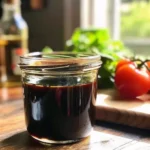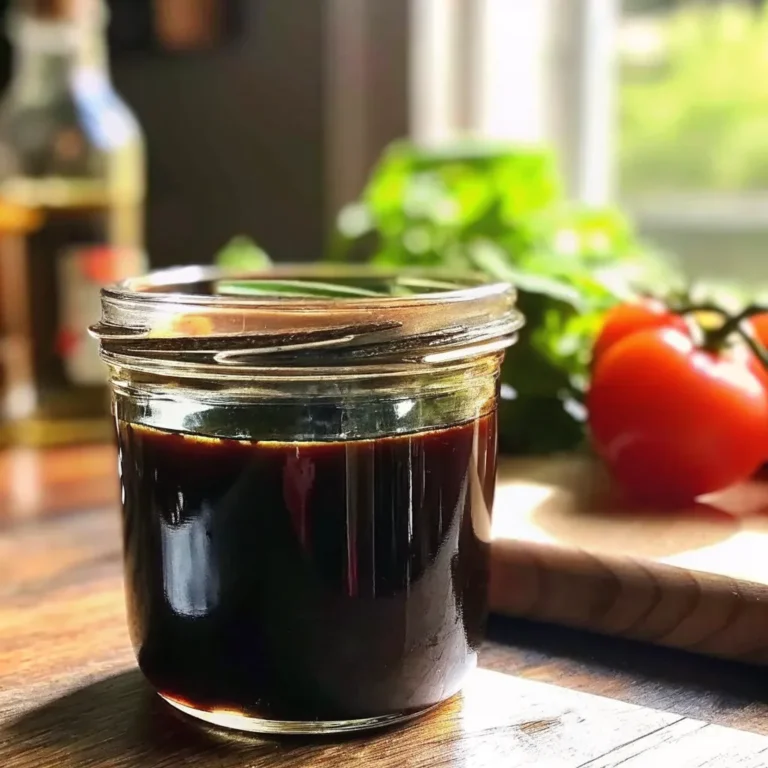Creating the perfect balsamic vinaigrette at home transforms ordinary salads into spectacular culinary experiences. Store-bought dressings often contain preservatives, artificial flavors, and lack the fresh, customizable flavor profile that homemade balsamic vinaigrette delivers. This comprehensive guide will teach you to create restaurant-quality balsamic vinaigrette using professional techniques, premium ingredients, and scientific principles that ensure consistent, delicious results every time. Whether you’re a beginner cook or experienced chef, mastering this essential dressing will elevate your salad game and provide a versatile foundation for countless meal variations.
Table of Contents
| Full recipe |
| Ingredients: Core Components: ¾ cup (180ml) extra virgin olive oil ¼ cup (60ml) high-quality balsamic vinegar 1 tablespoon Dijon mustard 1 teaspoon honey 2 cloves garlic, minced ½ teaspoon sea salt ¼ teaspoon freshly ground black pepper Optional Additions: 1 tablespoon fresh herbs (basil, oregano, or thyme) 1 teaspoon shallot, finely minced Equipment Needed Medium mixing bowl Wire whisk Measuring cups and spoons Airtight storage container |
| Step-by-Step Instructions: |
| Step 1: Prepare the Base In a medium mixing bowl, combine: Balsamic vinegar Dijon mustard Honey Minced garlic Salt and pepper Whisk thoroughly until honey dissolves completely and mixture is uniform. |
| Step 2: Create the Emulsion Slowly drizzle olive oil while whisking continuously in circular motions Continue whisking for 2-3 minutes until vinaigrette appears thick and creamy Test consistency – it should coat the back of a spoon lightly |
| Step 3: Season and Rest Taste and adjust seasonings as needed Let rest for 10-15 minutes to allow flavors to meld Whisk again before serving |
| Pro Tips for Success |
| Temperature Matters: Use room temperature ingredients for better emulsification If ingredients are cold, let them sit out for 15-20 minutes Emulsification Technique: Add oil very slowly at first (drop by drop) Maintain constant whisking motion If separation occurs, start over with small amount in clean bowl Quality Indicators: Good emulsion: Thick, creamy, stays mixed for several minutes Poor emulsion: Thin, separates immediately, oily surface |
Choosing High-Quality Ingredients for the Best Balsamic Vinaigrette
The foundation of exceptional balsamic vinaigrette lies in selecting premium ingredients that complement each other perfectly. Understanding ingredient quality differences will dramatically impact your final dressing’s flavor, texture, and overall appeal.
Selecting Premium Balsamic Vinegar
Authentic balsamic vinegar from Modena, Italy, provides the most complex flavor profile for your homemade dressing. Look for “Aceto Balsamico Tradizionale” on labels, which indicates traditional production methods and aging processes. High-quality balsamic vinegar exhibits rich, syrupy consistency with balanced sweetness and acidity. Avoid products with added sugars or artificial flavoring agents. Commercial-grade balsamic vinegars work adequately for everyday use, but investing in premium varieties elevates your balsamic vinaigrette significantly. Check ingredient lists carefully – authentic versions contain only grape must and vinegar.
Choosing the Right Olive Oil
Extra virgin olive oil provides the best flavor foundation for quality balsamic vinaigrette preparation. Cold-pressed varieties retain more nutrients and deliver superior taste compared to refined alternatives. Mediterranean olive oils, particularly from Spain, Italy, and Greece, offer distinct flavor profiles ranging from peppery to fruity. Store olive oil in dark containers away from heat sources to preserve freshness. Fresh olive oil should taste vibrant without rancid or bitter notes. Consider single-origin varieties for unique flavor characteristics that complement your specific salad preferences.
Essential Herbs and Seasonings
Fresh herbs dramatically enhance balsamic vinaigrette complexity and visual appeal. Basil, oregano, thyme, and rosemary pair beautifully with balsamic flavors. Dijon mustard acts as both flavoring agent and natural emulsifier, helping maintain proper consistency. Freshly cracked black pepper adds subtle heat, while sea salt balances acidity levels. Garlic, whether fresh, roasted, or powdered, provides aromatic depth. Honey or maple syrup can balance particularly acidic vinegars naturally.
Step-by-Step Classic Balsamic Vinaigrette Recipe with Emulsification Tips
Mastering proper balsamic vinaigrette technique ensures consistent results and professional presentation. This detailed recipe incorporates emulsification science for stable, well-integrated dressing.

Precise Measurements and Ratios
The traditional balsamic vinaigrette ratio follows 3:1 olive oil to vinegar proportions, creating balanced acidity and richness. For basic recipe: 3/4 cup (180ml) extra virgin olive oil, 1/4 cup (60ml) balsamic vinegar, 1 tablespoon Dijon mustard, 1 teaspoon honey, 2 cloves minced garlic, 1/2 teaspoon salt, 1/4 teaspoon black pepper. This recipe yields approximately 1 cup of finished dressing. Adjust ratios according to personal taste preferences – some prefer 2:1 ratio for milder acidity or 4:1 for richer consistency. For those seeking professional balsamic vinaigrette technique guide, exploring various ratio combinations helps develop personalized preferences.
Preparation Process
Begin by combining balsamic vinegar, Dijon mustard, honey, minced garlic, salt, and pepper in medium mixing bowl. Whisk thoroughly until honey dissolves completely and mixture appears uniform. Slowly drizzle olive oil while whisking continuously in circular motions. This gradual incorporation prevents separation and creates proper emulsification. Continue whisking for 2-3 minutes until balsamic vinaigrette appears thick and creamy. Taste and adjust seasonings as needed. For enhanced flavor development, let mixture rest 10-15 minutes before serving, allowing ingredients to meld properly.
Emulsification Science
Understanding emulsification principles helps create stable, professional-quality balsamic vinaigrette consistently. Emulsification occurs when water-based ingredients (vinegar) combine with oil-based components through mechanical action and emulsifying agents. Dijon mustard contains lecithin, a natural emulsifier that helps maintain proper suspension. Continuous whisking creates tiny oil droplets surrounded by water molecules, preventing separation. Temperature affects emulsification – room temperature ingredients blend more easily than cold components. Those interested in authentic Mediterranean dressing preparation will appreciate these traditional techniques passed down through generations.
Creative Variations and Flavor Combinations
Versatile balsamic vinaigrette serves as foundation for countless flavor variations and seasonal adaptations. Experimenting with different additions creates unique dressing profiles for specific dishes and occasions.
Herb-Infused Variations
Fresh herb additions transform basic balsamic vinaigrette into gourmet creations. Mediterranean blend combines basil, oregano, and thyme for classic flavor profiles. Italian-inspired versions feature fresh basil and sun-dried tomatoes for robust taste. Garden herb combinations using parsley, chives, and dill create lighter, fresher notes. For concentrated flavor, blend herbs directly into dressing using immersion blender. Dried herbs work adequately when fresh options aren’t available, but use half the quantity specified for fresh varieties.
Seasonal Adaptations
Seasonal ingredient additions keep balsamic vinaigrette interesting throughout the year. Spring versions benefit from fresh chives, early herbs, and light citrus zest. Summer adaptations incorporate fresh berries, stone fruit purees, or cucumber essence. Fall variations feature roasted garlic, caramelized shallots, or apple cider additions. Winter versions work beautifully with warming spices like cinnamon, nutmeg, or cardamom. These seasonal touches pair perfectly with dishes like classic chicken Caesar pasta salad recipe or lighter options such as refreshing carrot ribbon salad pairing.
Storage Tips and Shelf Life Management
Proper storage techniques maximize balsamic vinaigrette freshness and extend usable life significantly. Understanding storage principles prevents spoilage and maintains optimal flavor profiles.
Refrigeration Guidelines
Homemade balsamic vinaigrette stays fresh in refrigerated conditions for 7-10 days when stored properly. Use clean, airtight containers to prevent contamination and flavor absorption from other foods. Glass jars or bottles work best, as plastic containers may absorb flavors over time. Label containers with preparation dates for easy tracking. Before each use, allow refrigerated balsamic vinaigrette to reach room temperature for 10-15 minutes, then whisk thoroughly to re-emulsify separated components.
Signs of Freshness and Spoilage
Fresh balsamic vinaigrette maintains vibrant color, pleasant aroma, and smooth consistency when properly emulsified. Natural separation occurs during storage but easily corrects with vigorous whisking. Warning signs include off-odors, mold development, unusual color changes, or rancid smell from olive oil degradation. When in doubt, discard questionable dressing rather than risk foodborne illness. Quality ingredients and proper storage techniques significantly extend usable life while maintaining safety standards. For nutritional insights, refer to balanced balsamic vinaigrette formulation insights for additional guidance.

Troubleshooting Common Balsamic Vinaigrette Problems
Even experienced cooks encounter occasional challenges when preparing balsamic vinaigrette. Understanding common problems and their solutions ensures consistent success.
Fixing Separation Issues
Separation represents the most common balsamic vinaigrette challenge, but several techniques restore proper emulsification. Start with small amount of separated dressing in clean bowl, whisking vigorously while gradually adding remaining mixture. Alternatively, add small amount of Dijon mustard or egg yolk as additional emulsifier. Immersion blenders work effectively for stubborn separation problems. Prevention strategies include using room temperature ingredients, whisking continuously during oil incorporation, and adding emulsifying agents like mustard or honey.
Balancing Flavor Profiles
Overly acidic balsamic vinaigrette benefits from additional sweetness through honey, maple syrup, or fruit purees. Excessively sweet versions require more vinegar or citrus juice for balance. Too salty dressings need dilution with additional oil and vinegar in proper ratios. Bland flavors improve with garlic, herbs, or stronger mustard varieties. Taste testing during preparation allows for real-time adjustments before final storage.
Frequently Asked Questions
How long does homemade balsamic vinaigrette last in the refrigerator?
Properly stored homemade balsamic vinaigrette maintains freshness for 7-10 days in refrigerated conditions. Store in clean, airtight glass containers and label with preparation dates. Always check for signs of spoilage including off-odors, unusual color changes, or mold development before use. Natural separation occurs during storage but easily corrects with thorough whisking.
What ratio of balsamic vinegar to olive oil makes the best vinaigrette?
The classic balsamic vinaigrette ratio follows 3:1 olive oil to vinegar proportions, providing balanced acidity and richness. Some prefer 2:1 ratio for tangier flavor or 4:1 for milder, richer consistency. Personal taste preferences and intended use should guide ratio selection. Start with traditional 3:1 ratio and adjust according to individual preferences.
Can I make balsamic vinaigrette without oil for a healthier option?
Oil-free balsamic vinaigrette alternatives use vegetable broth, fruit juices, or pureed vegetables as base ingredients. While these options reduce calories, they lack traditional richness and emulsification properties. Consider using minimal high-quality olive oil for health benefits and improved texture, or experiment with avocado puree as creamy, nutritious substitute.
Why does my balsamic vinaigrette separate and how do I fix it?
Separation occurs when oil and vinegar molecules naturally repel each other without proper emulsification. Fix separated balsamic vinaigrette by whisking vigorously in clean bowl, gradually incorporating separated mixture. Adding small amounts of Dijon mustard, egg yolk, or honey helps re-establish emulsification. Prevent separation by using room temperature ingredients and continuous whisking during preparation.
What are the best herbs to add to balsamic vinaigrette?
Fresh herbs that complement balsamic vinaigrette include basil, oregano, thyme, rosemary, and parsley. Mediterranean combinations work particularly well with balsamic flavors. Use approximately 1-2 tablespoons fresh herbs per cup of dressing. Dried herbs require half the quantity of fresh varieties. Blend herbs directly into dressing for concentrated flavor or add whole leaves for visual appeal.
Can I use white balsamic vinegar instead of dark for vinaigrette?
White balsamic vinegar creates lighter-colored balsamic vinaigrette with slightly milder flavor profile. It works excellently for delicate salads or when color preservation matters. Use same ratios and techniques as traditional dark balsamic versions. White balsamic often costs more but provides elegant presentation for special occasions or light-colored ingredients.
Mastering homemade balsamic vinaigrette elevates your culinary repertoire and provides endless customization opportunities. The fresh, vibrant flavors of properly prepared dressing surpass any store-bought alternative while offering complete control over ingredients and consistency. With practice, creating perfect emulsification becomes second nature, ensuring restaurant-quality results every time. This versatile dressing pairs beautifully with countless salad combinations and works wonderfully with dishes like creamy deviled egg pasta salad variation for special occasions.

Start experimenting with your own balsamic vinaigrette variations today, using these professional techniques and quality ingredients to create signature dressings that reflect your personal taste preferences. Remember that practice makes perfect, and each batch provides opportunities to refine your technique and develop new flavor combinations that will impress family and guests alike.
Print
Perfect Balsamic Vinaigrette
- Total Time: 25 minutes
- Yield: 1 cup (16 servings) 1x
- Diet: Vegan
Description
Master the art of creating silky, restaurant-quality balsamic vinaigrette at home with this foolproof recipe. This versatile dressing combines the perfect balance of tangy balsamic vinegar, fruity olive oil, and aromatic seasonings to create a thick, creamy emulsion that elevates any salad from ordinary to extraordinary. With proper technique, you’ll achieve that coveted creamy consistency that coats greens beautifully and stays perfectly mixed.
Ingredients
- Core Components:
- ¾ cup (180ml) extra virgin olive oil
- ¼ cup (60ml) high-quality balsamic vinegar
- 1 tablespoon Dijon mustard
- 1 teaspoon honey
- 2 cloves garlic, minced
- ½ teaspoon sea salt
- ¼ teaspoon freshly ground black pepper
- Optional Additions:
- 1 tablespoon fresh herbs (basil, oregano, or thyme)
- 1 teaspoon shallot, finely minced
Instructions
- Prepare the Base: In a medium mixing bowl, combine balsamic vinegar, Dijon mustard, honey, minced garlic, salt, and pepper. Whisk thoroughly until honey dissolves completely and mixture is uniform.
- Create the Perfect Emulsion: Slowly drizzle olive oil while whisking continuously in circular motions. Start very slowly (drop by drop) for the first few tablespoons, then gradually increase to a thin stream.
- Achieve Creamy Consistency: Continue whisking for 2-3 minutes until vinaigrette appears thick and creamy. Test consistency – it should coat the back of a spoon lightly and stay mixed for several minutes.
- Season and Rest: Taste and adjust seasonings as needed. Add fresh herbs or minced shallot if using. Let rest for 10-15 minutes to allow flavors to meld.
- Final Preparation: Whisk again before serving to re-emulsify if needed. Store in an airtight container in refrigerator for up to 2 weeks.
Notes
Pro Tips for Success: Temperature matters – use room temperature ingredients for better emulsification. If ingredients are cold, let them sit out for 15-20 minutes. Emulsification Technique: Add oil very slowly at first (drop by drop) and maintain constant whisking motion. If separation occurs, start over with a small amount in a clean bowl. Quality Indicators: A good emulsion should be thick, creamy, and stay mixed for several minutes. A poor emulsion will be thin, separate immediately, and have an oily surface. Storage: Refrigerate in airtight container for up to 2 weeks. Bring to room temperature and whisk before using.
- Prep Time: 10 minutes
- Cook Time: 0 minutes
- Category: Condiment
- Method: No-Cook
- Cuisine: Mediterranean
Nutrition
- Serving Size: 1 tablespoon (1/16th of recipe)
- Calories: 95
- Sugar: 1g
- Sodium: 45mg
- Fat: 10g
- Saturated Fat: 1.5g
- Unsaturated Fat: 8g
- Trans Fat: 0g
- Carbohydrates: 1g
- Fiber: 0g
- Protein: 0g
- Cholesterol: 0mg
Keywords: balsamic vinaigrette, homemade salad dressing, emulsified vinaigrette, olive oil dressing

